2016 Annual Report for EW15-023
Sustaining the Future of Navajo Rangelands via Mobile Learning Tools to Promote Enhanced Vegetation Management
Summary
New Mexico State University’s range scientists, media development team and the Tri-State Navajo Nation Extension professionals are working together to develop a Navajo/English mobile tool and agricultural professional support system to help Navajo range managers sustain the future of their Navajo rangelands. This integrated program will address specific management needs identified by Navajo producers and support documentation of vegetation and range conditions.
Objectives/Performance Targets
The primary objective for this proposal is to provide Navajo agricultural professionals, farmers and ranchers with an easy-to-use, up-to-the-minute mobile tool that will support efforts to improve rangeland ecology, maximize productivity and encourage sustainability. The project team proposes to do this by:
1. Developing an innovative mobile tool that allows professionals and producers to access information on effective rangeland management methods while out on the range. The tool will support photo documentation of vegetation and range conditions, thus creating a forum for Navajo agricultural professionals, ranchers and farmers to gather and share current data with other agricultural professionals and producers.
a. Project team members will confer with Extension rangeland experts in the region and use existing resources to draw content to use in the tool and ensure it provides updated information.
b. Navajo Extension professionals will be involved throughout the process to ensure information is correct and effective for their target audience.
2. Training Navajo agricultural professionals on how to effectively educate Navajo producers about improving rangeland management and sustainability methods through use of the tool.
3. Implementing the tool in the field, thus increasing agricultural professionals’ knowledge and confidence by providing “any time, anywhere” accessibility of information on mobile devices with specific content related to sustainable rangeland management on the Navajo reservation.
Accomplishments/Milestones
- In Summer 2016, a prototype version of tool was tested with Navajo range managers in Window Rock, NM, and the team heard first-hand about range managers' needs and preferences for tool. A user-testing professional made a record of these observations. In response to user testing and comment, project team members reformulated the design of the planned tool, including changing aspects of its organization, searchability, and presentation and refocusing on creating additional online database functionality.
- During Fall 2016 project team members continued to refine the plant database and mobile-accessible tool. Information in the plant database underwent review by content matter experts (rangeland managers and rangeland ecologists). In collaboration with Gerald Moore, the team continued assembling content for the final database, including adding some plants not previously included in the database. Further efforts included confirming scientific names of plants whose names had changed in recent botanical nomenclature, confirming common names of plants in English and Navajo, and collecting more locally appropriate images of plants from USDA, BLM, and other sources.
- Gerald Moore, along with a Navajo language specialist, has delivered additional Navajo language audio files to and has continues working with a Navajo language specialist regarding best practices for Navajo font use on mobile devices and computers. The NMSU team has tested the audio files and has incorporated Navajo script and Navajo language audio into a subset of the database. (This process is ongoing.)
- NMSU has acquired the following URLs, which will be used for dissemination of the mobile tools and web-accessible searchable database of plants. They are currently not yet live.
Impacts and Contributions/Outcomes
- Navajo rangeland managers, working through Gerald Moore of the Tri-State Navajo Nation Extension unit, were involved in project development, and in providing feedback on prototypes development in conjunction with NMSU scientists and the development team. Navajo agency professionals have also been involved throughout the process to ensure information is correct and effective for their target audience. In Fall 2016, after visiting Window Rock, NM for user testing, the team received ongoing contributions of images, information, and advice from agency personnel and others who forged connections to the project during testing.
- During user testing with Navajo range managers in Window Rock, NM, development team members observed, recorded, and analyzed responses from participants and produced a 12-page user-testing journal describing these findings.
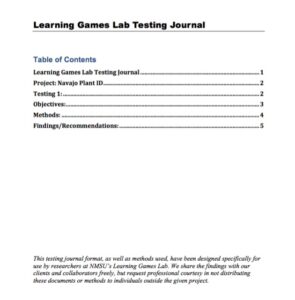
Table of Contents page of the user-testing journal -
An online interface for a mobile-accessible searchable web database of plants was further enhanced in 2016 (based on an earlier prototype). This will allow users to define their plant search using characteristics such as alternative names, plant type, flower color, habitat, growing season, or special concerns. Incorporating the full set of data, Navajo names, and Navajo audio into this website is ongoing.
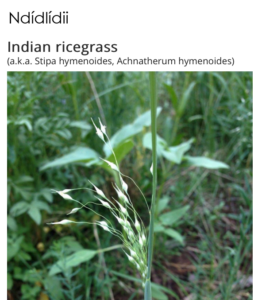
Screenshot of a page from the mobile accessible searchable database
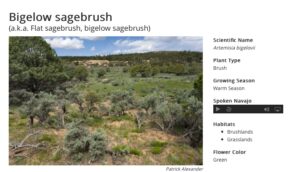
Screenshot of a page from the mobile-accessible searchable web database
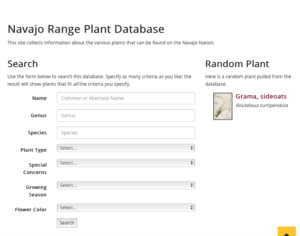
Screenshot of the search interface of the mobile-accessible webpage -
A downloadable version of the same information is also under development, to enable offline use.
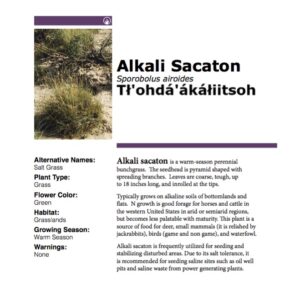
Page from the downloadable version of the guide for offline use.